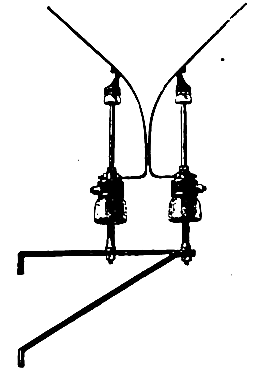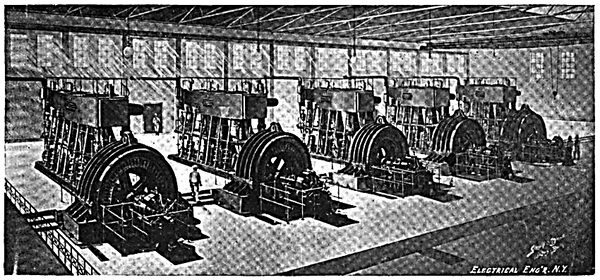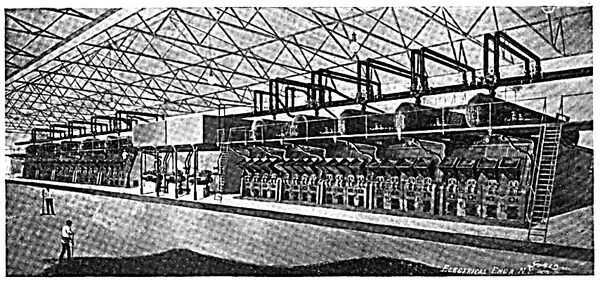[Trade Journal]
Publication: The Electrical Engineer
New York, NY, United States
vol. 24, no. 500, p. 521-522, col. 1-2
ELECTRIC LIGHTING
THE RAND CENTRAL ELECTRIC WORKS.
THE rapid development of the Transvaal gold mines on the Witwatersrand has brought about a considerable increase in the motive power required for the various mines, which extend for a distance of 25 miles east and west of Johannesburg, in the Transvaal. It is estimated that at present about 20,000 h. p. in engines is installed along these mines. When one considers that these engines represent an aggregation of small units, and that some of them are by no means of most recent type, it will be readily understood that the average efficiency of the steam engines of the Rand is far from the maximum. The richest companies have already replaced their old and scattered plants by groups containing modern steam engines of larger power, and consequently more economical. But, nevertheless, the quantity of coal consumed in the various mines is enormous. This enormous consumption of coal has in fact frequently caused a blockade on the railroads around Johannesburg, and several mines have been forced to shut down temporarily for lack of coal. Besides this, some companies, having no contracts with the Netherland Railway, hate suddenly had their provision cut off since the appearance of the rinderpest. In addition the freight rates are known to be very high on general merchandise and on coal in particular.
This combination of conditions some time ago gave rise to the proposition to establish not far from the Rand a central power station capable of furnishing electric energy to the various mines for hauling and lighting. The preliminary plans were discussed in 1894, and the first proposition was to utilize the falls of the River Vaal, but Mr. Singels, director of the Rand Central Electric Works, finally rejected this plan, owing to the lack of water in the dry season. The station was finally located on the property of the Brak-Pan mine, owned by the Transvaal Coal Trust Co., close to the mine shaft.
| |||
| Fig. 1. — Dynamo Room, Rand Central Electric Works, Johannesburg, South Africa. |
In the meantime the new company had obtained from the government of the Transvaal Republic a franchise for lighting Johannesburg and transmitting power by overhead wires to the Witwatersrand. The contract with the coal company binds the latter to furnish the Rand Central Electric Works all coal required by it for a period of fifty-five years.
The plans for the station were rapidly drawn up, and work begun September 1, 1895. Owing to an agreement with the railway company all the material arrived at the spot without transshipment. The engine and dynamo room, illustrated in Fig. 1, measures 230 feet long by 76 feet wire, and 52 feet high. The framework is of iron, and the roof, as well as the walls, are of wood covered with corrugated iron. A 25-ton overhead crane was erected at the very start and assisted in the erection of the machinery. The machines are all mounted on a continuous bed of concrete, resting on hard rock about 16 feet below the level of the floor.
The boiler room, illustrated in Fig. 2, is 250 feet long and 48 feet wide. It has two wings, each capable of taking in five boilers. The two iron chimneys are 16 feet in diameter at the base and 10 feet at the top. The coal storage is sufficient to hold a reserve for several months. Complete arrangements for unloading have been installed. The coal being raised to the storage pockets by an Archimedean screw, which brings the coal to the foot of the wall of the boiler house. Automatic stokers of the Leach system are employed. The ashes are raised in small wagons on a special track. The entire operation of the boilers and fuel is effected electrically by motors taking current from the large dynamos. The boiler feeding was made a special study, owing to the fact that the quantity of water available was limited. To prevent corrosion of the tubes and to obviate their frequent cleaning surface condensation was adopted, and no fresh water enters the boilers without being filtered.
The engine room contains four upright triple expansion engines of 1,350 h. p. These engines, operating at 100 revolutions per minute, are direct connected to the dynamos and their exciters. Each unti [sic] unit has a normal capacity for 1,000 h. p.; one of them being always held in reserve gives an available 3,000 h. p. to distribute among the motors at the various mines, at which point 2,100 h. p. can be effectively counted on.
The dynamos and the entire electrical apparatus were furnished by Messrs. Siemens & Halske, of Berlin. Each machine is of 1,145 kilowatts capacity. The armatures are stationary, in the form of a ring having a diameter of 16 feet. The field magnet revolves within the armature, being keyed to the shaft driven from the engine. Each machine weighs 80 tons, and was made in four parts so as to facilitate transportation.
| |||
| Fig. 2. — Dynamo Room, Rand Central Electric Works, Johannesburg, South Africa. |
The dynamos generate three-phase current at 700 rolts. Step-up transformers raise the potential at the station 10,000 volts, at which pressure the current is transmitted over the line, The principal line is overhead, and consists of six copper wires carried on steel poles 20 feet high. The longest line is over 28 miles in length.
In order to guard against lightning the Siemens & Halske lightning arrester has been successfully employed; this arrester is illustrated in Fig. 3, and was described in detail in our issue of May 12, 1897. Tests with a pressure of 20,000 volts have shown this form of arrester to act promptly and effectively.
 |
| Fig. 3. — High Potential Lightning Arrester. |
At every point where the current is utilized, that is, close to each mine, the Rand Central Electric Works has erected a transformer house, as well as measuring instruments and safety appliances. The transformers in these little houses step down the pressure from 10,000 to 120 volts for lighting, or to 240 or 500 volts for motors. The price charged for current is lower than that for which the mines can produce it themselves. The charge is [dollar:$225] per h. p. per annum, the power being measured at the electric motor shaft. For intermittent use, such as at Johannesburg, electric meters are employed, where the charge is from 3 to 3 1/2 cents per h. p. hour.


